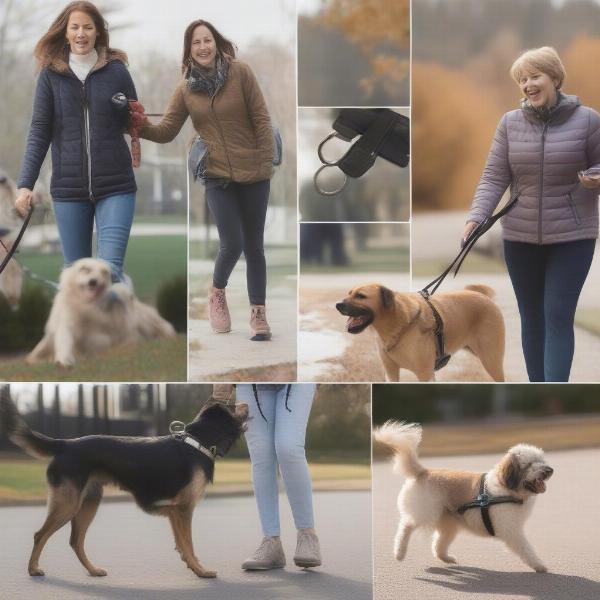Anxious dog leads, also known as calming leads or anti-anxiety leads, are designed to help ease a dog’s anxiety during walks. These specialized leads can be a game-changer for nervous or reactive dogs, offering more control and a sense of security. If you’re dealing with an anxious pup, finding the right lead can make a world of difference in your walks. This article will discuss the various types of anxious dog leads, how to choose the best one for your furry friend, and how to use them effectively.
Understanding Anxious Dog Leads and Their Benefits
Anxious dogs often display signs of stress during walks, such as pulling, lunging, barking, or cowering. These behaviors can stem from fear, overexcitement, or lack of proper training. An anxious dog lead works by gently distributing pressure across the dog’s body, creating a calming effect similar to a gentle hug. This can help reduce pulling and lunging, making walks more enjoyable for both you and your dog. They also often provide more control over the dog, preventing escapes or unwanted interactions with other dogs or people.
How to Choose the Right Anxious Dog Lead for Your Dog
Choosing the right anxious dog lead depends on your dog’s size, breed, temperament, and the specific anxieties they exhibit. Here are some factors to consider:
- Front-Clip Harnesses: These harnesses clip at the dog’s chest, discouraging pulling by gently steering them back towards you. They are a good choice for dogs who tend to pull or lunge forward.
- Head Halters: These resemble a muzzle but function differently. They gently control the dog’s head, allowing you to redirect their attention. Head halters are effective for dogs who are highly reactive or tend to lunge at other dogs or people.
- Back-Clip Harnesses with Double-Ended Leads: This combination allows for more control and can be particularly useful for larger or stronger dogs.
Using an Anxious Dog Lead Effectively
Simply using an anxious dog lead is not enough. You must also use it correctly and combine it with consistent training. Here’s how:
- Proper Fit: Ensure the lead fits snugly but not too tightly. A loose lead can be ineffective, while a too-tight lead can cause discomfort.
- Positive Reinforcement: Use positive reinforcement techniques like treats and praise to reward calm behavior during walks.
- Consistency: Be consistent in your training and use of the anxious dog lead. This helps your dog learn the desired behavior.
- Desensitization and Counter-Conditioning: Gradually expose your dog to their triggers (e.g., other dogs, loud noises) while using the lead and rewarding calm behavior. dog crate midwest can be a safe haven for your dog in such situations.
 Tips for Walking an Anxious Dog
Tips for Walking an Anxious Dog
Beyond the Lead: Additional Tips for Anxious Dogs
While an anxious dog lead can be helpful, it’s important to address the underlying anxiety as well. Consider these additional tips:
- Consult a Veterinarian or Certified Dog Trainer: They can provide tailored advice and training strategies for your dog’s specific needs. Sometimes, they might recommend products like xmas dog pjs to create a sense of security.
- Create a Calm Environment: Ensure your home is a safe and relaxing space for your dog.
- Regular Exercise: Provide regular physical and mental stimulation through walks, playtime, and puzzle toys. Places like holly lodge dog field can be excellent for exercise and socialization.
- Maintain a Routine: A consistent routine can help reduce anxiety in dogs.
Conclusion
Choosing the right anxious dog lead can significantly improve your dog’s walking experience and reduce anxiety. Remember to consider your dog’s individual needs and combine the lead with consistent training and positive reinforcement. By addressing your dog’s anxiety holistically, you can help them enjoy walks and live a happier, more relaxed life. If you’re considering professional photos with your furry friend, look into options for santa photos dogs.
FAQ
- What is the best anxious dog lead for a small dog? A front-clip harness or a head halter can be suitable for small dogs, depending on their specific anxieties.
- Can an anxious dog lead cure anxiety? Anxious dog leads are a management tool, not a cure. They can help control anxiety during walks, but it’s important to address the underlying anxiety.
- How long does it take for an anxious dog lead to work? The effectiveness varies depending on the dog and the consistency of training. It may take several weeks or even months to see significant improvement.
- Can I use an anxious dog lead on a puppy? Yes, you can use an anxious dog lead on a puppy, but ensure it fits properly and doesn’t restrict their movement.
- Are anxious dog leads cruel? When used correctly and fitted properly, anxious dog leads are not cruel. They can actually help improve a dog’s quality of life by reducing stress during walks.
- My dog hates the head halter, what should I do? Try a different type of anxious dog lead, such as a front-clip harness. It’s crucial to find a lead that your dog is comfortable with.
- Where can I buy an anxious dog lead? Anxious dog leads are available at most pet stores and online retailers.
ILM Dog is a leading international website dedicated to providing expert advice and resources for dog owners worldwide. We offer comprehensive information on various topics, including dog breeds, health, training, nutrition, grooming, and much more. Our mission is to empower dog owners with the knowledge and tools they need to provide the best possible care for their canine companions. Whether you need help selecting the right breed, understanding your dog’s health needs, or finding the perfect mobile dog grooming telford service, ILM Dog is here to support you every step of the way. Contact us today via email at [email protected] or phone at +44 20-3965-8624 to learn more about our services.